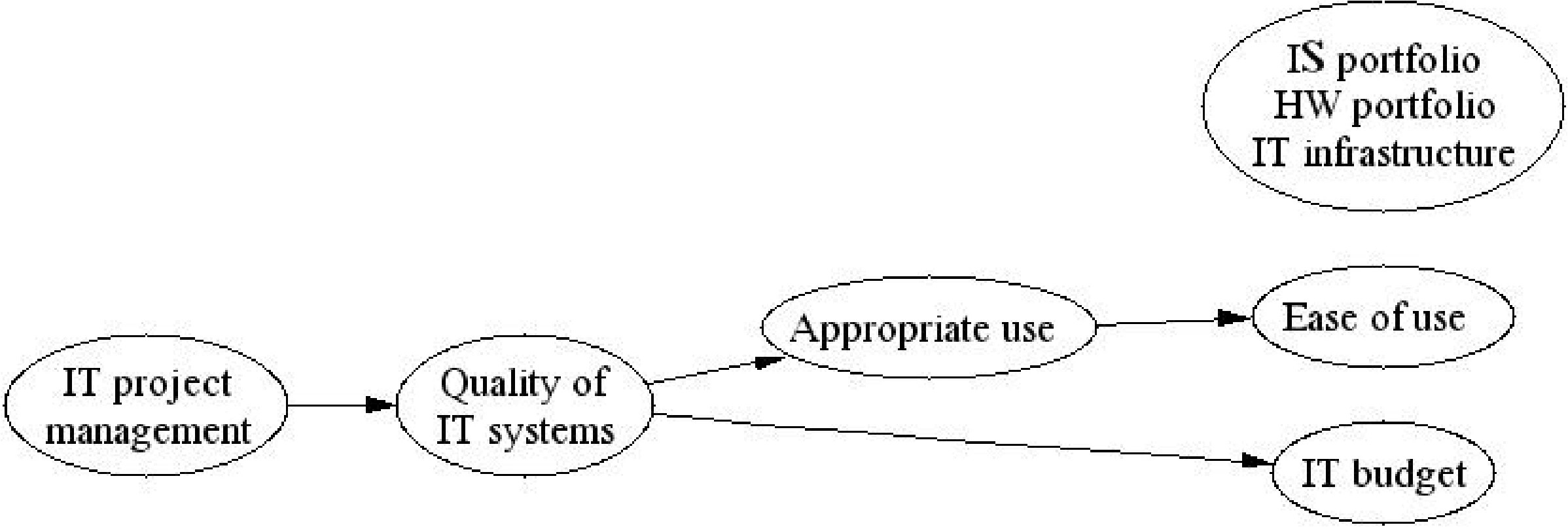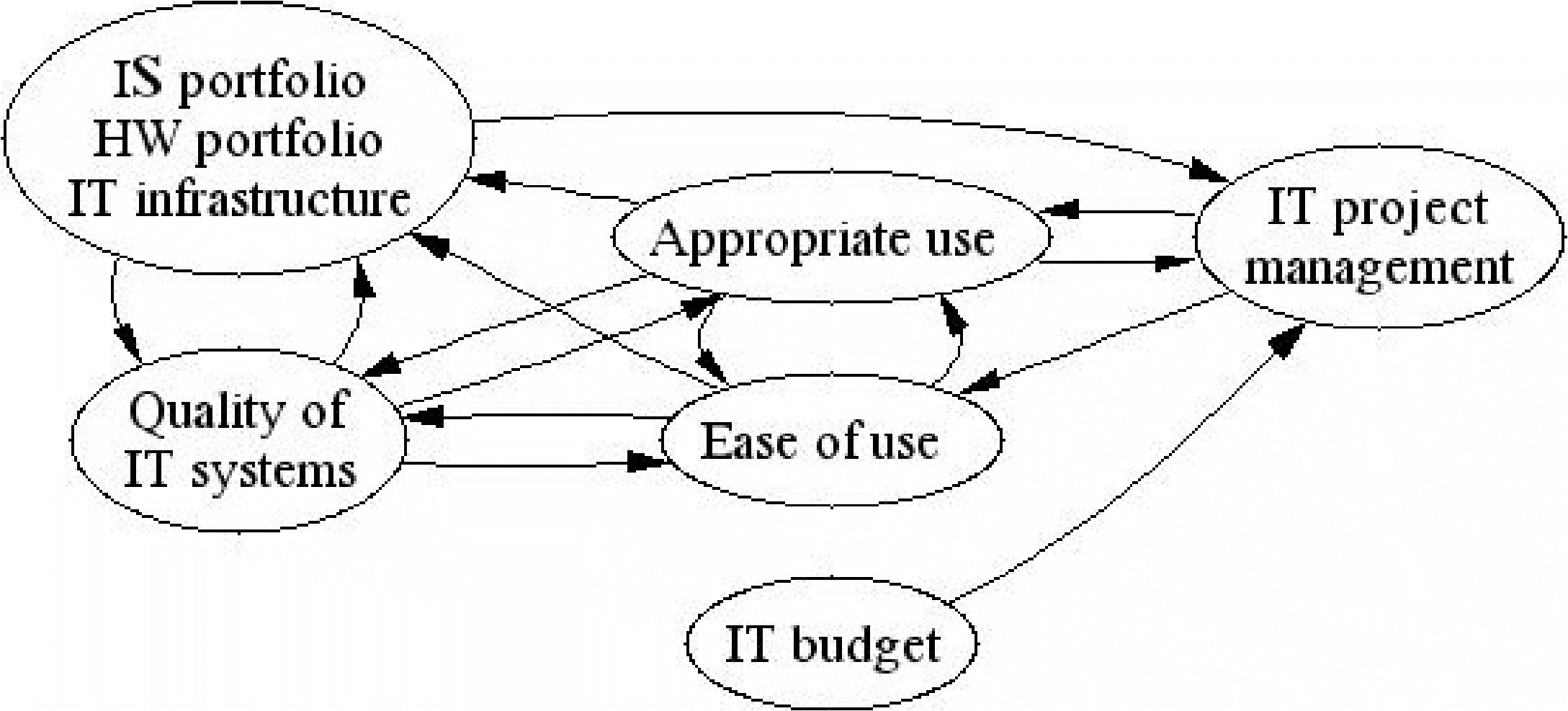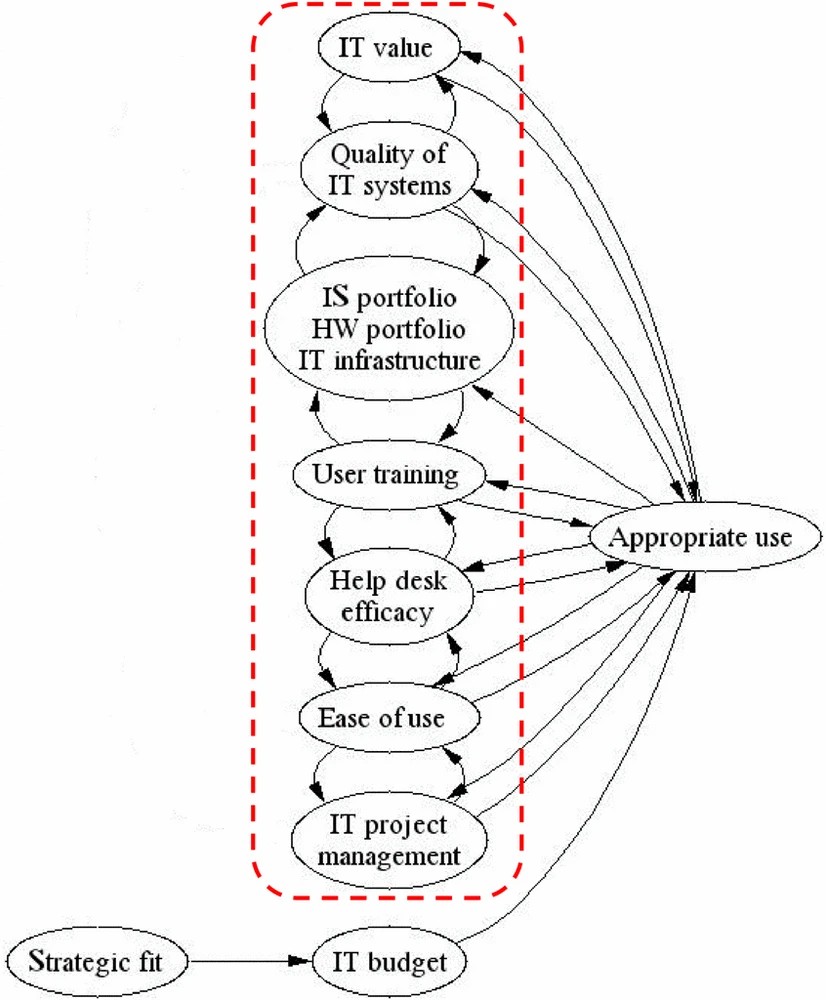Abstract
1. Introduction
Information technology (IT) has experienced expansive growth in recent decades as firms have invested heavily to create operational efficiencies via streamlined and centralized processes in an effort to remain competitive in the modern era. Investment in maintaining older and implementing new IT systems remains high as firms try to determine how IT will fit within their respective organizations. The net result of these investments in IT infrastructure has been mixed. Numerous studies have yielded evidence of a so-called “productivity paradox” [1],[3],[9] where firms invest in technology without receiving the benefits of increased profitability. Moreover “the fact that organizations were spending more and more on information technology with little to show for it in the output statistics forced practitioners to redouble their efforts to justify investments in technology [13]”. There are many contributing factors they are typically given as reasons why these systems fall short of expectations, for example: lack of flexibility to address the changing needs of the organization as it grows; poor implementation practices, poor testing during development leading to the roll-out of a “buggy” product and the lack of understanding by both the organization and the IT developer as to the functional requirements for the IT system.
Understanding that there continues to be high investment and relatively low productivity gains and perhaps even lower customer satisfaction with these IT system implementations, we are led to an important question. What variables impact individual and organizational productivity when using or developing IT systems? Does IT investment lead to increased productivity, and if so how much should a firm invest in IT to maximize its benefits without over spending? This paper shows that these questions are made even more difficult to answer because of the heterogeneity of views that different stakeholders bring to and IS use context.
By using interpretive structural modeling, this paper addresses the persistent problem of understanding the value of information technology (IT) and developing frameworks to effectively leverage IT and complementary assets. Given that studies by Brynjolfsson and Hitt [3] and others have shown that IT does add value in the longer run, we investigate how an organization can derive greater benefits and sooner. Since the value of IT to an organization is experienced at different levels (individual, group ad enterprise) and since processes associated with IT use and IT management change and mature over time, we employ the notion of the “collective mind” [16] to analyze how users and managers of IT heedfully interrelate with one another, this collective understanding and shared set of expectations can help to derive enhanced value from IT and related assets.
2. Background
In the 1990s researches [3] began to gather evidence and provided statistics that looked at IT effectiveness on a large number of specific firms rather than large aggregate sectors of the economy, such as manufacturing or agriculture. The availability of company-specific data allowed researchers to combine the obvious variables affecting productivity, such as increased profitability with subtle factors such as convenience or increased quality.
From these more recent results, it became evident that the metrics researchers used to determine IT effectiveness was a significant factor to the earlier productivity paradox assertion. In the 1970s researchers were still using industrial-age measurements, such as quantity of output earned per each unit of input, as opposed to metrics that more appropriately reflected the changing economic base (e.g., rapid growth of the service sectors) and an increasing move from mass production systems to synthetic production systems, which allow for heavy customization (e.g., common in the software industry). The IT revolution has transformed the ways workers conduct their jobs, and as a result it is necessary to identify a new set of parameters to measure productivity. This is most evident in the services sector were organization have become less hierarchical and flatter in the decision making process. Constraints on today's employee include product quality, timeliness, customization, convenience, variety and other intangibles.
An increasingly reliance on information systems has necessitated an even greater investment in IT assets. This investment is comprised of hardware, software, telecommunications infrastructure, and real estate for housing and data backup. Additionally, large expenditures on training, process redesign, value-added service partners and other organizational changes accompany the more tangible IT investments. Only as we begin to look at all of these parameters will a framework for measuring the success of information technology investment become evident.
3. Methodology
In this paper the “process view” is utilized to view how investments in IT and other related activities contribute to an organization's overall value. Some organizations, have reaped the benefits of adopting this process view, but many other firms have not been able to do so, and are floundering to create effective systems. The process view has a number of advantages, compared to the previously used variance theory, in determining IT effectiveness. The variance theory is sufficient to explain the difference in the magnitude of an outcome only when that outcome is certain, suggesting that those variables may not be adequate to explain the outcome. The process view on the other hand, is capable of explaining the causal relationship between variables when an outcome is uncertain.
Using a base set of constructs of information orientation from Marchand et al. [10] and by invoking using Kelly's [8] theory of personal constructs (which argues the individual develop and adopt their own sense making frameworks and constructs), we operationalize this study by adopting a process view [7],[5],[11],[13]. This view places the analytical lens on how individuals' and collective beliefs help derive IT-enabled benefits as opposed to the correlates of IT-value - which has been the thrust of past studies. We used the interpretive structural modeling (ISM) [12],[14],[15] to collect, analyze and synthesize the data.
ISM falls into the soft operations research (OR) family of approaches. Soft OR methods can be used to augment traditional quantitative methods, but do not replace traditional tools and techniques [6]. ISM is a process that helps groups of people in structuring their collective knowledge. The term ISM refers to the systematic application of graph theory in such a way that theoretical, conceptual, and computational leverage is exploited to efficiently construct a directed graph, or network representation, of the complex pattern of a contextual relationship among a set of elements. In other words, it helps to identify structure within a system of related elements. It may represent this information either by a digraph (directed graph) or by a matrix.
Using the process view allows the researcher to pay explicit attention to the assumed nature of the causal relationships between the chosen variables. As noted by Soh and Markus, “The causation consists of necessary conditions occurring in a particular sequence in which change and random events play a role.” Therefore, the use of the process view can help to explain factors that contribute to the “so-called” productivity paradox described in earlier research. The variance theory concept addresses the “productivity paradox” by linking variables in a very rigid manner; there are specific outcomes with specific variable patterns that do not consider the role of time. The process view on the other hand introduces the role of time and in turn develops a flexible modeling system that accommodates the different variables in measuring IT. In turn, this allows the researcher to go beyond the limits of the productivity paradox because the model and variable used allows for the researcher to consider time and sequences in which change and random events occur.
Variables
The first task in determining the effectiveness of an IT system utilizing the process view is to identify those variables and constructs that make an IT system valuable to the organization. The methodology used for this project required we first look at six variables that are generic to IT systems as a whole throughout different industries.
1. Quality of IT Systems -
This variable looks at the relative importance an organization places on the overall quality of the IT system. Quality can be defined as the aggregate perception of the organization's users concerning the degree to which the current IT systems meet their needs. In other words does the quality of the IT system increase end user productivity?
2. Quantity of IT Systems -
This variable looks at the importance of the number of IT systems to the organization productivity. How does the quantity of hardware, software and other IT-related components specifically relate to the organization's effectiveness.
3. Budget of IT -
This variable examines the importance of the IT-related budget to the organization. Marcus and Soh argue that there is typically an insufficient relationship between the amount spent on IT and improved organizational performance due to poor management and inappropriate allocation. This factor is often the starting point and determining factor for managers to consider before purchasing and developing an IT system. Therefore, this factor in combination with quantity and quality develops a full picture of what Soh and Marcus [13] term “IT assets”.
4. Time Allocated to Develop IT Solutions -
This variable can be considered generic to all IT systems due to the role of time in the adoption and acceptance of IT systems within an organization. In process theory, (contrasted to variance theory) the element of time is crucial because it allow for the proper sequencing of contributing factors.
5. Ease Of Use
This variable measures factors contributing to the utilization of an IT system by an organization's end users, such as uptime, intuitiveness and operability. The importance of the variable lies in the belief that the easier the IT system is to the user, the more value it will add to the organization.
6. Appropriate Use-
This variable is a measure of how IT systems increase firm performance through intended utilization. This variable measures two principal conditions: first, whether the IT solution is designed to fit the task effectively, and second once the system is designed is the system actually used. A system that does not meet the functional requirements of the organization and its users, or if it is not actually used becomes irrelevant.
For this research, we identified how each variable contributes to every other variable through the use of a survey given to individuals at three levels of managing IT systems at a construction company. It is a $2 billion commercial construction company based in Maryland. In following this process view methodology we can demonstrate the extent to which each variable impacts every other variable and that the end state is comprised of a series of necessary conditions occurring in a particular sequence, but affected by factors outside consideration.
Individuals at three management levels - the Project Engineer, Project Manager and Senior Project Manager - were involved in this study. These levels of management were chosen because they are involved with the IT system in different capacities and deal with the IS differently. The interviews looked at the ten variables and asked the individual being interviewed to relate the variables to the contextual relationship “contributes.” In comparing each variable the user defines the variables that are most important to them. The aggregated survey results are inputted into an MS Excel-based analytical tool to generate the structure of the information system, process and transformation framework. The structure of the six generic variables and the variables with context-specific attributes is run to evaluate the responses of the three layers of management tested. Answers provided by survey participants were inputted into the model using a V, A, X or O. The “V” indicates that the row variable contributes to the column variable. The “A” indicates that the column variable contributes to the row variable. “X” indicated that both variables contribute to each other. Finally, the “O” indicates that they two variables do not contribute to each other.
4. The case study background
Lagging slightly behind other industries in the United States, the wave of IT system development hit the commercial construction industry in the mid-1980s. Jobs and standards that had been established over many years have transformed completely in less than a decade. For example, drafting documents for years had been considered a time honored “craft”, however the advent of Computer-Aided Design (CAD) technology has completely transformed this skill. CAD technology reduced what took a team of draftsman hours to complete by hand a fraction of the time and expense previously required. A second example is the introduction of software development to the industry, which has allowed for a drastic reduction in the number of engineers required to design and review the structural system of a building. The introduction of web-based communication devices is yet another example of the transformation of the construction industry through the use of IT. Construction engineers in the field can pass letters, requisitions and drawings to other stakeholders through the use Web-based communications software such as Construct-Ware and Prolog.
In order to meet the information needs of the organization, the construction company has had to develop IT solutions to maintain communications between headquarters and the field while observing strict costing controls. The result has been an incremental process that has slowly evolved over the years. Due to the thousands of people that are involved with a given construction site and the slow technology adoption rate of some of the organization's stakeholders, the firm has had to maintain various IT solutions and methods of communication. The typical format is that the construction engineers maintain dialogues with information workers such as architects, structural engineers and owner/developers through the use of Internet software, email and costing software. Communication with sub-contractors requires the use of more traditional formats such as fax, telephone and mail due to the slow adoption of IT by these smaller organizations. While other industries and organizations have been able to flatten their decision making process through the use of IT, the construction industry has maintained a hierarchical structure in part to accommodate the controls necessary to continue a dual dialogue system: one for the information workers and one for the more traditional stakeholders.
For the information workers the construction company maintains two types of IT systems; those that are uniform throughout the organization and those solutions that are only provided to specific users. The accounting and financial systems are uniform throughout the company. The accounting and financial package is supported by an AS400 system utilizing JD/Edwards software. The system uses process controls to maintain consistency and accountability, such as strict adherence to a cost code structure and position-based spending limits. The company utilizes a Lotus Notes email system to incorporate calendars, mailing lists, and construction site databases. All users get standard Microsoft products such as Power Point, Word and Excel.
While simultaneously supporting these standardized solutions, the company has had to also maintain individual custom software for individual needs. For example, the engineers need structural engineering software such as Beam 2-D, drafters require CAD software and estimators need estimating software.
Until recently the company been has been plagued by various “kinks” in the distribution of crucial IT solutions to dispersed construction sites. Instead of streamlining the hardware and software packages, the company originally tried to have individual solutions for each sites, resulting in inconsistent delivery of IT solutions to end-users. For example, some of the construction sites had high-speed connections while other struggled with dial-up connections. As a result of the inconsistency in IT delivery a heavy strain was placed on the IT Department to provide support to the organization. In the past, the department had response times to IT issues as long as two to three days. In the last two years the department underwent a reorganization, and response times were reduced to 15 minutes for a response and 24 hours for a solution.
Organization Specific Variables
To properly assess the relationship between IT solutions and productivity in the construction industry four new organization-specific variables have been added to the original six variables discussed earlier:
7. Strategic Fit -
This variable describes how well selected IT solutions match the overall strategy of the company. The company is currently working under a regional expansion strategy and Strategic Fit was selected to assess how a specific IT investment matches this strategy.
8. Help Desk Efficacy -
This variable was selected to assess the effectiveness of the help desk in both responding to and solving IT related issues. Effectiveness of Help Desk was selected because of the significance of solving IT issues when establishing multiple project specific field offices.
9. User Training -
This variable was selected to assess how well the company trains employees in the use of specific software applications.
10. IT Value-
This variable was selected to assess the extent that a specific IT Investment contributes to the organization's overall success. IT value was selected because of the increasing importance of IT to project success.
With the new variables it is possible to incorporate an organization-specific analysis in determining the critical path of IT systems at the company. The first step is to evaluate the organization using the original six variables introduced in this paper that are relevant to most industries. Once this model has been established it then becomes useful to incorporate the variables that are specific to an organization in the construction industry, in evaluating productivity.
The company employs eight layers of management: CEO, President, Senior Vice President,
Vice President, Project Executive, Senior Project Manager, Project Manager, Project
Engineer and Office Engineer. Each of these layers has different levels of control,
spending accountability and production responsibility and often contribute to the
continuation of a significant bureaucratic structure. The higher ranks in the organization
deal with strategy, client relations and overall management of staff. Project managers
and senior engineers, on the other hand, conduct daily operations and manage projects,
and were therefore selected to evaluate the effectiveness of IT systems within the
organization.

Figure 1.Figure 1.

Figure 2.Figure 2.

Figure 3.Figure 3.

Figure 4.Figure 4.
5. Results and analysis
We present results associated with three respondents. We present how the project engineer views IT-related constructs. We follow that up by the views from the project manager and finally the senior project manager. The raw data are provided in Appendix B.
The project engineer's views are shown in Figure 1 and 2. To the engineer, IT project management (time constraints and project control frameworks) to develop IT solutions was the primary driving variable closely followed by quality of IT systems in both the six and ten variable models. However, when company-specific variables are introduced (see Figure 2), appropriate use and effectiveness of help desk feature become increasing important as driving force variables. This structure can be explained as a result of the nature of an engineer's work that includes maintaining correspondence with subcontractors, owners, engineers and architects. An engineer's work also involves maintaining costing software, project specific databases and conducting structural design. Due to heavy reliance on technology, an engineer places particular importance on high quality and service in regards to information systems, which is reflected in the driving variables. On the other hand, the outcome variables: budget of IT and quantity of IT are less important to the engineer because he/she does not have to think about these strategic issues on a day to day basis in order to maintain their work.
The project manager's understanding of the situation is shown in Figure s 3 and 4. To the project manager, (3) budget was the driving variable closely followed by
(4) time allocated to develop IT solutions. This makes sense because outside of engineers,
project managers are the most familiar with IT systems. They work with the systems
day to day and rely heavily on the development of the systems. However, the Project
Manager must manage projects within monetary constraints, which might explain why
they would place budgetary concerns as the driving variable. Similar to the engineer,
the IT project management is accorded an important position and drives many of the
other factors. This might be explained if we view Project Managers as seeing the quality
of the IT systems firsthand, they are responsible for making recommendations to senior
management and are ultimately concerned with the quality these recommended systems
produce.

Figure 5.Figure 5.

Figure 6.Figure 6.
The senior project manager's interpretive structural models are shown in Figure s 5 and 6. Similar to the engineer and the project manager, the senior project manager ranks (4) time allocated to develop IT solutions and (3) budget for IT systems as the driving variables. The senior project managers are ultimately responsible for the quality of the IT systems, and devote more of their time to monetary concerns than the other two positions. Senior Project Managers at the company are directly responsible for developing and executing budgets and are consequently concerned with the value produced per dollar spent.
6. Implications
Utilizing the process view to evaluate the variables determining IT effectiveness offers many valuable insights. For the purposes of this project, certain variables were seen to be the predominant drivers of an IT system's value within an organization. Of the original six variables, three were consistently ranked by the survey respondents among the most important contributing factors in an IT system's contribution toward organizational value. These three were: (1) quality of IT systems, (3) budget spent on IT services and (4) time allocated to develop IT solutions. These results make sense in context of the positions being surveyed. The Project Engineer, Project Manger and Senior Project Manager can be considered low to mid level management with the organization who have contact with IT systems in their daily work and have varying degrees of budgetary authority. These positions are primarily interested in quality information technology systems that are reasonably priced, developed according to their specifications and delivered in a suitable timeframe. It should be noted that the personnel that were closer to everyday operations (i.e., the Project Engineer) had a clearer picture of what was important in relation to IT systems.
When the four additional variables that are specific to the company are introduced one variable in particular, Effectiveness of Help Desk, becomes more of a driver. Due to their reliance on information systems to complete daily work, the Project Engineer and the Project Manager both consider this variable as an important factor in IT effectiveness. When the system crashes it is critical that they resolve all IT issues in a timely fashion. It makes sense that the positions that rely the most on the IT systems for their job will consider the effectiveness of the help desk as a crucial driver for IT value. It should also be noted that the Senior Project manager shows less clarity and an overall weaker grasp on the situation regarding IT effectiveness, as there are no clearly delineated “drivers” in the results.
The process paradox can be linked to the phenomenon that organizations often tend to respond to symptoms of problems as opposed to their causes. This reaction to symptoms is a result of either incomplete understanding of an issue or different sets of understandings associated with the issue. As our results show, new variables are required to properly account for all the direct and indirect influencers of the contributions of IT systems to organizational productivity. Unlike the industrial age, “output should include not just the number of widgets coming out of a factory, or the line of code produced by a programming team, but rather the value created for consumers (Brynjolfsson and Hitt, 1998).” These factors should indicate to the company's IT managers that value not just output is of concern for the company's stakeholders, and need to be considered when selecting and evaluating IT systems. A specific extension of this line of thinking can be seen by correlating a traditional measure of IT effectiveness with more company specific variables to get a clearer picture of the value contributed to an organization through the use of IT systems. Traditionally, managers would attempt to resolve productivity issues with increased IT budgets, however these increases did not necessarily correlate to increased productivity. Under the process view we can demonstrate that the IT budget combined with other company specific variables such as time allocated to develop IT solutions and Help Desk Effectiveness can assist in the evaluation of IT effectiveness and can help IT managers determine how best to allocate scarce budgetary dollars.
Given that IT is crucial in organizational operations, and given further that, there is a surprising lack of consensus on how IT works to add value in an organization, it is important that organizations strive to develop a collective understanding and develop sense making frameworks within their organizations. Such a “collective mind” (Weick and Roberts) will enable IT users and providers to “heedfully interrelate” when it comes to drivers and inhibitors of IT-enabled productivity.
7. Conclusion
The analysis performed in this report evaluates the value placed on IT systems by a construction company. The data gathered indicates that the company's information workers and other stakeholders (like vendors) consider both traditional variables and these newer value-based variables as important to the success of the organization. Increasing the budget devoted to IT does not necessarily correlate to increased productivity. However, when the budget variable is matched with an understanding of the time allocated to develop IT solutions and help desk efficacy variables, IT managers of the company are better armed with useful information that can be utilized to answer how best to allocate its budget and how best to respond to the demands of the company's information workers across all management levels and jobs functions. Continued monitoring of these variables will provide a better understanding of bottlenecks that exist in the system that adversely impact workers quality and productivity. Developing action plans to diminish these bottlenecks will help increase the company's productivity and system user satisfaction for years to come.
Our main findings were the following: individuals widely differ in how they perceive IT adds value; there are many indirect influencers of IT value and these influencers offer IT managers the managerial and operational leverage to amplify IT value. Importantly, we showed that since the objectives of the different stakeholders are often incongruent, the collective mind of an organization could appear incoherent when it comes to understanding IT value.
Our framework allows managers to identify such gaps and address them so that users and managers of IT can “heedfully interrelate” to leverage IT value. The theoretical implication of the study lies in demonstrating and encouraging the process view of IT in organizations and in showing how qualitative analytical techniques. We believe that in this paper we have been able to “focus on the concerns of practice, provide real value to [IS] professionals Benbasat and Zmud (1999, p. 5)” by balancing the pragmatic and academic tone.
Appendix A: Ism
Interpretive structural modeling (ISM) analyzes a system of elements and resolves these in a graphical representation of their directed relationships and hierarchical levels. The elements may be objectives of a policy, goals of an organization, factors of assessment , etc. The directed relationships can be in a variety of contexts (referred to as contextual relationships), such as Element (i) “is greater than” “is achieved by” “will help achieve” “is more important than” Element (j). The following is a brief description of the different steps of ISM:
- i)Identification of Elements: The elements of the system are identified and listed. This may be achieved through research, brain storming, etc.
- ii)Contextual Relationship: A contextual relationship between elements is established, depending upon the objective of the modeling exercise.
- iii)Structural Self Interaction Matrix (SSIM): This matrix represents the respondents perception of element to element directed relationship.
Four Symbols are used to represent the type of the type of relationship that can exist
between two elements of the system under consideration. These are:
-
V… for the relation from element to , but not in the reverse direction;
-
A … for the relation from to , but not in the reverse direction;
-
X … for an interrelation between and (both directions);
-
O … to represent that and are unrelated.
-
- iv)Reachability Matrix (RM): A Reachability Matrix is then prepared that converts the symbolic SSIM Matrix into
a binary matrix. The following conversion rules apply:
-
If the relation to in SSIM, then element and in RM
-
If the relation to in S SIM, then element and in RM
-
If the relation to in SSIM, then element and in RM
-
If the relation to in SSIM, then element and in RM
-
- v)Level Partitioning: Level partitioning is done in order to classify the elements into different levels of the ISM structure. For this purpose, two sets are associated with each element of the system - A Reachability Set that is a set of all elements that can be reached from the element , and an Antecedent Set , that is a set of all elements that element can be reached by.In the first iteration, all elements, for which , are Level I Elements. In successive iterations, the elements identified as level elements in the previous iterations are deleted, and new elements are selected for successive levels using the same rule. Accordingly, all the elements of the system are grouped into different levels.
- vi)Canonical Matrix: grouping together elements in the same level develops this matrix. The resultant matrix has most of its upper triangular elements as 0, and lower triangular elements as 1. This matrix is then used to prepare a Digraph.
- vii)Digraph: Digraph is a term derived from Di rectional Graph, and as the name suggests, is a graphical representation of the elements, their directed relationships, and hierarchical levels. The initial digraph is prepared on the basis of the canonical matrix. This is then pruned by removing all transitivities, to form a final digraph.
- vii)Interpretive Structural Model: The ISM is generated by replacing all element numbers with the actual element description. The ISM therefore, gives a very clear picture of the system of elements and their flow of relationships.
Appendix B: Raw data for ISM
Element key
- 1.Quality of IT systems
- 2.IS portfolio HW portfolio IT infrastructure
- 3.IT budget
- 4.IT project management
- 5.Ease of use
- 6.Appropriate use
- 7.Strategic fit
- 8.Help desk efficacy
- 9.User training
- 10.IT value



References
- [1]AndersonM. C. ; BankerR. D. and RavindranS. , “The new productivity paradox”, Communications of the ACM, 46 (3), 2003, pp. 9194.
- [2]Benbasat, I. and Zmud, R.W (1999) “Empirical research in information systems: The practice of relevance”, MIS Quarterly, 23 (1), 3–16.
- [3]Brynjolfsson, E. and Hitt, L. M. , “Beyond the productivity paradox”, Communications of the ACM, 41 (8), 1998, pp. 49–55.
- [4]Brynjolfsson Erik and Hitt Lorin (1998). Beyond the Productivity Paradox, Communications of the ACM, 41 (8), 49–55.
- [5]Crowston, K . (2000). Process as theory in information systems research, In The IFIP WG 8.2 International Conference: The Social and Organizational Perspective on Research and Practice in Information Technology. Aalborg, Denmark.
- [6]Glasow, P. A. (2000). An American Foray Into Soft OR: A Report on the Conduct of a Case Study in Partial Fulfillment of the Requirements for a Ph. D. Program, The MITRE Corporation, presented at the International Symposium for Military Operational Research, August 2000. http://www.mitre.org/workitech_papers/tech_papers_00/glasow_american/glasow.pdf
- [7]Kanungo, S . (2003). Using Systems Dynamics to Operationalize Process Theory in Information Systems Research, Proceedings of the International Conference on Information Systems, ICIS2003 December 14–17 2003, Seattle, Washington, USA, 450–463
- [8]Kelly, G . (1955). The psychology of personal constructs. 2 Volumes, New York: Norton, 1955.
- [9]King, W. R. , “IT capabilities, business processes, and impact on the bottom line”, Information Systems Management. Boston, 19 (2), 2002, pp. 85–87.
- [10]MarchandD. A. ; KettingerW. J. and RollinsJ. D. (2000). Information Orientation: People, Technology and the Bottom Line, Sloan Management Review, 41 (4), 69–80.
- [11]Newman, M. and Robey, D. (1992). A social process model of user-analyst relationships, MIS Quarterly, 16 (2), 249–266.
- [12]Sage, A. P. and Smith, T. J. (1977). On group assessment of utility and worth attributes using interpretive structural modeling, Computers and Electrical Engineering,. v4 (1977).
- [13]Soh, C. and Markus, M. L. “How IT creates business value: A process theory synthesis”, Proceedings of the Sixteenth International Conference on Information Systems, 1995, pp. 29–41.
- [14]Warfield, J. N. (1973). Intent structures, IEEE-SMC, 3 (2), 133–140.
- [15]Warfield, J. N. (1974). Structuring complex systems, Battelle Monograph Number 4, Battelle Memorial Institute, Columbus, OH.
- [16]Weick, K.E. and Roberts, K.H. (1993) Collective mind in organizations: Heedful interrelating on flight decks, Administrative Science Quarterly, 38 (3), 357–381.

